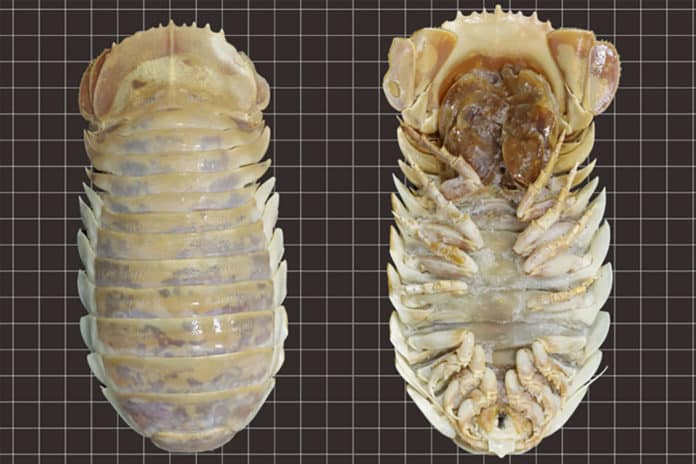Bathonymus, a mysterious and primitive group that lives in the benthic zone of the ocean—its deepest parts—has about 20 species as of today. Isopod crustaceans are only distantly related to their more well-known decapod relatives, the crabs, shrimp, and lobsters.
Now, scientists have added one latest creature to this list. A group of Taiwanese, Japanese, and Australian scientists has discovered B. yucatanensis, a new species which is around 26cm long – some 2,500% larger than the common woodlouse.
The discovery of this new species of Bathonymus adds another addition to the isopod pantheon. It brings the total of known species of Bathonymus in the Gulf of Mexico to three. The first – B. giganteus- was discovered in 1879, and the second B. maxeyorum was described in 2016.
Initially, the new specimen was thought to be a variation of B. giganteus. After closer examination, the specimen was found to have an array of unique features that makes it morphologically distinct from both B. giganteus and B. maxeyorum.
The specimen was originally captured in a baited trap in 2017 in the Gulf of Mexico off the Yucatán Peninsula at around 600 to 800 meters down.
Scientists noted, “Compared to B. giganteus, B. yucatanensis has more slender body proportions and is shorter in total length … and the pereopods [thoracic limbs] are more slender. It also has longer antennae. The two species have the same number of pleotelson spines. These spines protrude from the tail end of the crustacean.”
“Bathynomus giganteus was discovered over a century ago. More than 1,000 specimens have been studied with no suggestion until now of a second species with the same number of pleotelsonic spines. Superficial examination, using only pleotelson spines, could easily result in specimens of B. yucatanensis being misidentified as B. giganteus.”
“Compared with B. maxeyorum, the most distinctive feature is the number of pleotelson spines—11 spines in B. yucatanensis versus 7 in B. maxeyorum. The blotchy, creamy yellow coloration of the shell further distinguished it from its greyer relatives.”
Scientists conducted a molecular genetic analysis, in which they compared B. giganteus and B. yucatanensis. Due to the different sequences of the two genes (COI and 16S rRNA), coupled with differences in morphology, they identified it as a new species. The phylogenetic tree they constructed showed B. yucatanensis as most closely related to B. giganteus.
Scientists noted, “B. giganteus is indeed the species closest to B. yucatanensis. This indicates that the two species likely had a common ancestor. Additionally, there may also be other undiscovered Bathynomus spp. in the tropical western Atlantic.”
Journal Reference:
- Ming-Chih Huang, Tadashi Kawai, et al. A new species of Bathynomus Milne-Edwards, 1879 (Isopoda: Cirolanidae) from the southern Gulf of Mexico with a redescription of Bathynomus jamesi Kou, Chen and Li, 2017 from off Pratas Island, Taiwan. Journal of Nature History. DOI: 10.1080/00222933.2022.2086835
